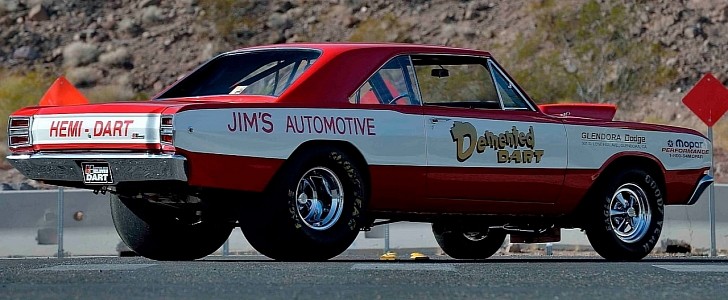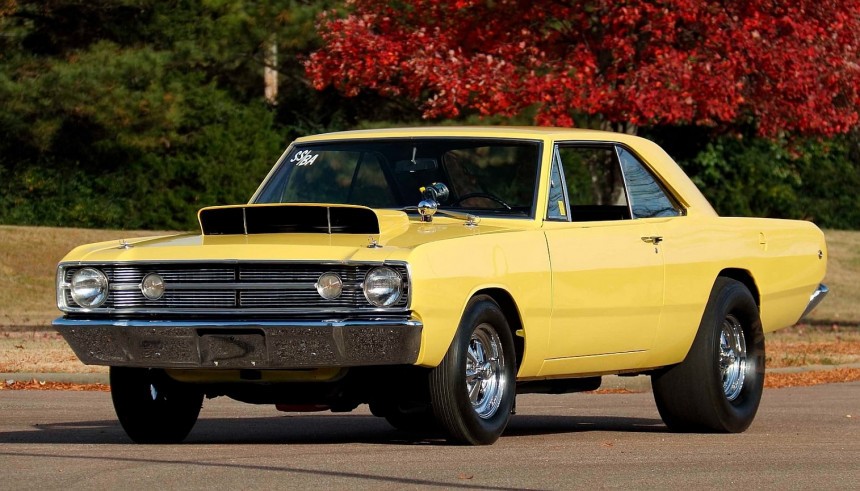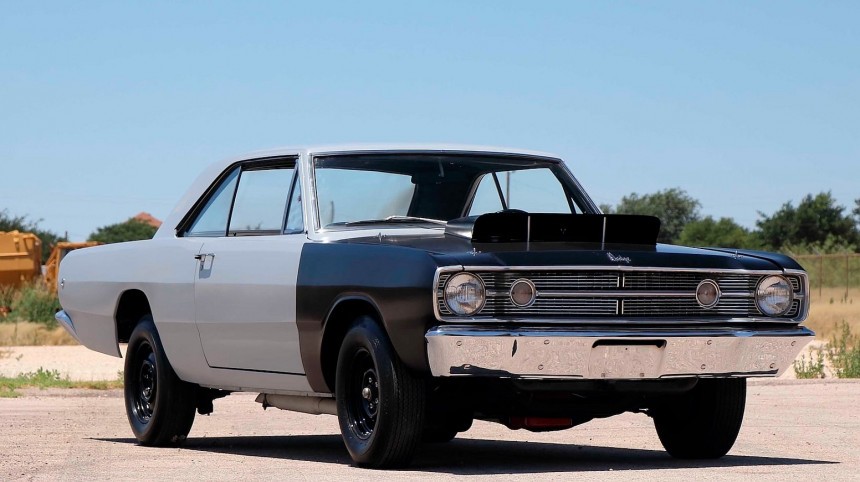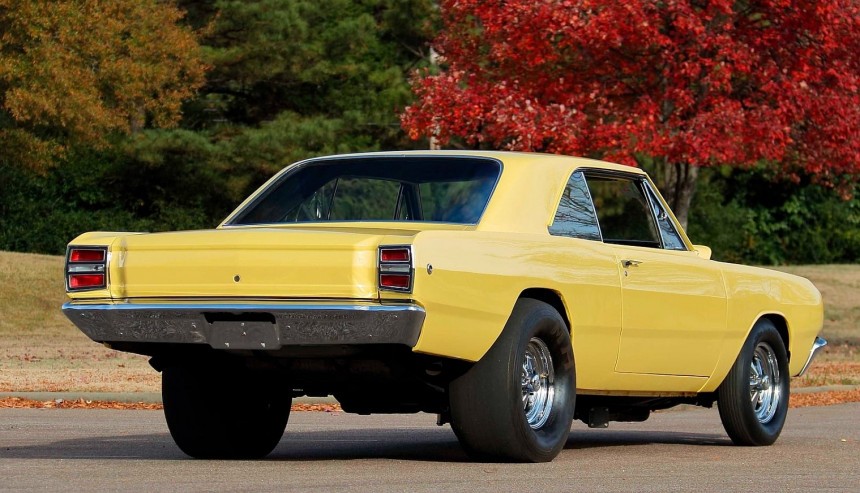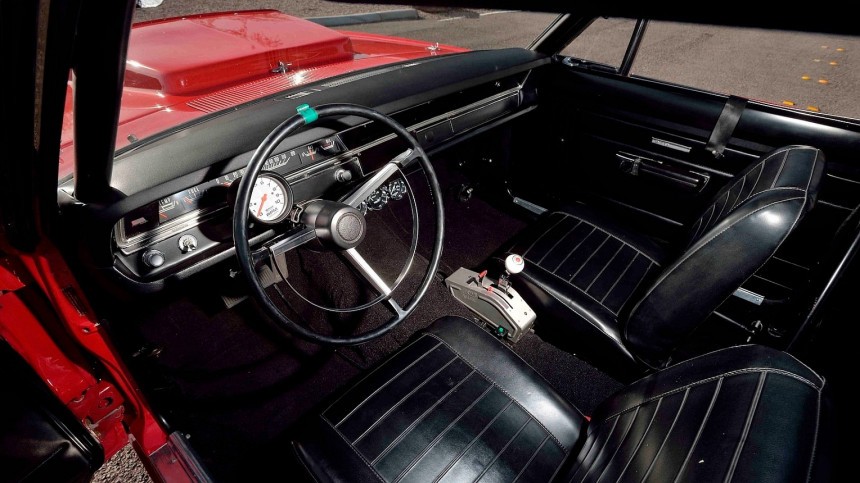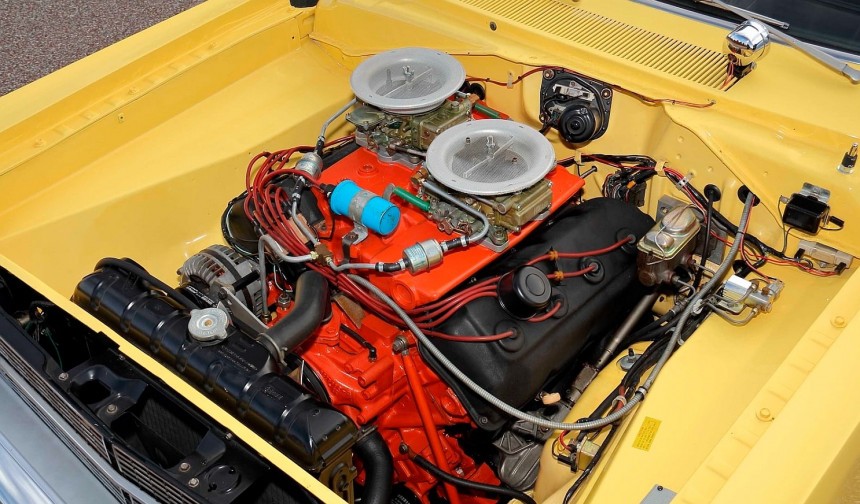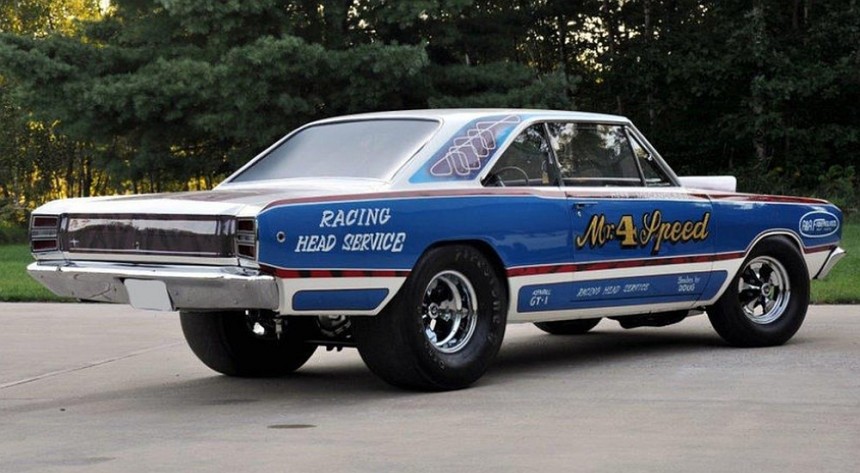When it comes to factory-built drag cars, we usually remember the Ford Thunderbolt, Chevrolet Impala Z11, Pontiac Catalina Super Duty, and the Dodge Hemi Coronet A990. Of course, there are many more notable dragsters out there, but we often forget that Dodge also created a drag-ready, Hemi-powered Dart.
Born as a full-size car in 1960, the Dart became a midsize vehicle in 1962 before it was downsized again to a compact in 1963. While the short-lived midsize version left a mark on the performance market thanks to the 413-cubic-inch (6.8-liter) Wedge V8 good for 415 horsepower, the compact that replaced it didn't have much to brag about at first.
In its four years on the market, the third-gen Dart was offered with only one V8 in the form of a 273-cubic-inch (4.5-liter) unit. Initially rated at 180 horsepower, it was upgraded to 235 horses in 1965. Quite decent for a mid-1960s compact, but far from what high-performance intermediates were capable of at the time.
That changed when the fourth and final generation Dart arrived in 1967. With the muscle car wars in full swing, Dodge gave the Dart a sportier appearance and a full-blown coupe version. It also gradually added the bigger V8 engines available in the larger Charger, Coronet, and Polara.
By 1970, the Dart had arrived in dealerships not only with the 340-cubic-inch (5.2-liter) LA and the 383-cubic-inch (6.3-liter) RB but also with the mighty 440-cubic-inch (7.2-liter) V8, which was good for 375 horsepower.
The 440-equipped Dart was a big deal in terms of power-to-weight ratio. While it was just as powerful as its midsize counterpart, the Dodge Charger, it was almost 400 pounds (181 kg) lighter. But before the Dart became available with the 440, Dodge made a surprising move and dropped the mighty 426-cubic-inch (7.0-liter) Hemi V8 in the compact.
It all happened in February 1968, when Dodge dealerships across the U.S. received promotional materials containing Chrysler's intention to sell factory-built Dart dragsters equipped with the company's most powerful V8.
It was assigned production code LO23, and it was built to meet Class B Super Stock racing specifications. Yup, it came with a no-warranty disclaimer.
But while Dodge's regular-production Hemi cars were put together at the company's plant, the Hemi Darts had to go to Hurst Performance in Madison Heights, Michigan, for the finishing touches. In reality, Hurst did a lot more than that because the Darts reached the company's conversion facility as partially assembled chassis.
In theory, the Hemi Dart was based on the GTS hardtop, but it went through radical modifications to become an LO23. While the Dart was already lighter than the Charger and the Coronet, Dodge took the opportunity and shaved even more pounds off the compact.
The regular steel fenders and hood were replaced with fiberglass panels, while the acid-dipped doors featured thinner glass and lacked window mechanisms (they were strap-operated).
Like most factory-built dragsters from the era, the Hemi Dart was devoid of a rear bench. But the regular front seats were also replaced with simpler and lighter units sourced from the Dodge A100 van. Because no one needs lateral support while racing in a straight line.
Of course, Dodge also removed all equipment deemed unnecessary at the drag strip. The list included the center console, heater, sound deadening material, side mirrors, radio, carpeting, and armrests. Period literature says the Hemi Dart tipped the scales at around 3,000 pounds (1,361 kg), around 500 pounds (227 kg) lighter than a 440-equipped GTS.
On top of that, the Hemi Dart looked downright menacing thanks to the massive and impressively wide scoop on the hood. It also featured four pins for full lift-off removal. Because drag racing involves a lot of under-the-hood meddling at the strip. Finally, Hurst made modifications to the rear fenders to accommodate bigger rear wheels wrapped in slick tires.
Power came from the 426 Hemi V8 that Chrysler had been using to terrorize the competition at the drag strip and on public roads since 1964.
Breathing was courtesy of 2x4-barrel Holley carburetors, a cross-ram aluminum intake manifold, and a compression ratio of 10.25:1. The race-bred powerplant was advertised to deliver 425 horsepower and up to 490 pound-feet (664 Nm) of torque.
Granted, it wasn't more powerful than the Hemi offered in the Charger or the Coronet, but these numbers were massive in the Dart's lightweight setup. But that was on paper, as some claim it came with more than 500 horsepower on tap.
Dodge offered both four-speed manual and three-speed transmissions for the Hemi Dart. The manual gearboxes had their synchronizers removed to lower the chances of missing shifts and were paired to Dana heavy-duty rear axles with 4.88 gear ratios.
The automatic, which was Chrysler's then-new 727 TorqueFlite, came with 4.86 rear gears and a high-speed torque converter.
The heavy-duty rear shocks and radiator, the high capacity oil pump, solid-lifter cam, and the roller timing chain also helped the Hemi Dart score impressive runs over the quarter-mile. Dodge claimed that the compact would cover the distance in less than 11 seconds at 130 mph (209 kph), notably quicker than a Hemi-powered Charger.
Minor tweaks enabled racers to score low-10-second passes, while drivers like Dick Landy managed to achieve nine-second runs.
The Hemi Dart became the car to beat in no time and dominated Class B Super Stock racing for years to come. Even when Dodge rolled out a Super Stock version of the Challenger in 1970.
Make no mistake, though, these cars were designed to meet street-legal requirements. However, due to their extensive modifications and aggressive setups, the Hemi Darts came with disclaimers that they were not for street use.
Like most factory-built dragsters, the LO23 Hemi option disappeared from dealer sheets as suddenly as it appeared. The bundle was nowhere to be found by 1969, so the Hemi Dart remained a one-year offering.
With only 80 cars built in 1968, the Hemi Dart is the rarest iteration of the compact and a hard-to-find classic nowadays.
A somewhat affordable racer back in the day, the 1968 Hemi Dart is now an expensive collectible. They rarely show up at auction, and when they do, they either fetch big bucks or remain with their respective owners due to high reserves.
A quick look at Hemi Dart auctions in recent years reveals that most of them failed to sell for prices between $170,000 to $200,000. However, a low-mileage example in excellent condition went under the hammer for a whopping $302,500 at a Mecum Auctions sale in January 2022.
Far from cheap, but more affordable than more mundane Mopars with Hemi engines.
In its four years on the market, the third-gen Dart was offered with only one V8 in the form of a 273-cubic-inch (4.5-liter) unit. Initially rated at 180 horsepower, it was upgraded to 235 horses in 1965. Quite decent for a mid-1960s compact, but far from what high-performance intermediates were capable of at the time.
That changed when the fourth and final generation Dart arrived in 1967. With the muscle car wars in full swing, Dodge gave the Dart a sportier appearance and a full-blown coupe version. It also gradually added the bigger V8 engines available in the larger Charger, Coronet, and Polara.
By 1970, the Dart had arrived in dealerships not only with the 340-cubic-inch (5.2-liter) LA and the 383-cubic-inch (6.3-liter) RB but also with the mighty 440-cubic-inch (7.2-liter) V8, which was good for 375 horsepower.
It all happened in February 1968, when Dodge dealerships across the U.S. received promotional materials containing Chrysler's intention to sell factory-built Dart dragsters equipped with the company's most powerful V8.
It was assigned production code LO23, and it was built to meet Class B Super Stock racing specifications. Yup, it came with a no-warranty disclaimer.
But while Dodge's regular-production Hemi cars were put together at the company's plant, the Hemi Darts had to go to Hurst Performance in Madison Heights, Michigan, for the finishing touches. In reality, Hurst did a lot more than that because the Darts reached the company's conversion facility as partially assembled chassis.
The regular steel fenders and hood were replaced with fiberglass panels, while the acid-dipped doors featured thinner glass and lacked window mechanisms (they were strap-operated).
Like most factory-built dragsters from the era, the Hemi Dart was devoid of a rear bench. But the regular front seats were also replaced with simpler and lighter units sourced from the Dodge A100 van. Because no one needs lateral support while racing in a straight line.
Of course, Dodge also removed all equipment deemed unnecessary at the drag strip. The list included the center console, heater, sound deadening material, side mirrors, radio, carpeting, and armrests. Period literature says the Hemi Dart tipped the scales at around 3,000 pounds (1,361 kg), around 500 pounds (227 kg) lighter than a 440-equipped GTS.
Power came from the 426 Hemi V8 that Chrysler had been using to terrorize the competition at the drag strip and on public roads since 1964.
Breathing was courtesy of 2x4-barrel Holley carburetors, a cross-ram aluminum intake manifold, and a compression ratio of 10.25:1. The race-bred powerplant was advertised to deliver 425 horsepower and up to 490 pound-feet (664 Nm) of torque.
Granted, it wasn't more powerful than the Hemi offered in the Charger or the Coronet, but these numbers were massive in the Dart's lightweight setup. But that was on paper, as some claim it came with more than 500 horsepower on tap.
The automatic, which was Chrysler's then-new 727 TorqueFlite, came with 4.86 rear gears and a high-speed torque converter.
The heavy-duty rear shocks and radiator, the high capacity oil pump, solid-lifter cam, and the roller timing chain also helped the Hemi Dart score impressive runs over the quarter-mile. Dodge claimed that the compact would cover the distance in less than 11 seconds at 130 mph (209 kph), notably quicker than a Hemi-powered Charger.
Minor tweaks enabled racers to score low-10-second passes, while drivers like Dick Landy managed to achieve nine-second runs.
Make no mistake, though, these cars were designed to meet street-legal requirements. However, due to their extensive modifications and aggressive setups, the Hemi Darts came with disclaimers that they were not for street use.
Like most factory-built dragsters, the LO23 Hemi option disappeared from dealer sheets as suddenly as it appeared. The bundle was nowhere to be found by 1969, so the Hemi Dart remained a one-year offering.
With only 80 cars built in 1968, the Hemi Dart is the rarest iteration of the compact and a hard-to-find classic nowadays.
A quick look at Hemi Dart auctions in recent years reveals that most of them failed to sell for prices between $170,000 to $200,000. However, a low-mileage example in excellent condition went under the hammer for a whopping $302,500 at a Mecum Auctions sale in January 2022.
Far from cheap, but more affordable than more mundane Mopars with Hemi engines.
